Abstract
The US Army recently updated their fitness test from a historical three-task battery to a science-driven six-task battery called the Army Combat Fitness Test (ACFT). The Army chose the six events compared to the time required to complete a battery of commons soldier tasks (CSTs), thus targeting the time-domain aspect of physical requirements and capability. We aimed to critically evaluate the new ACFT using biomechanical analyses and digital human modeling to assess how well specific aspects of the ACFT tasks matched required joint torques to perform common soldier tasks. This paper will focus on one of the ACFT tasks, the dead lift. Five healthy ROTC students (three males, two females) completed simulated CSTs and the ACFT. All were instrumented with markers to use 3D motion analysis coupled with digital human modeling (DHM) using Santos® and Sophia® DHMs to estimate the muscle joint torque requirements (i.e., workloads) needed to complete each task. We assessed five major joints in the body: trunk (low-back extension and abdominal flexion), hip flexion/extension, knee flexion/extension, shoulder flexion/extension, and elbow flexion/extension. The ratio of peak torques needed to complete selective CSTs compared to the torque needed to complete the deadlift at the current passing score were modeled, where < 100% indicates the CSTs were less strenuous than the deadlift. We found examples of less, similar, and greater strength requirements across eight CSTs compared to the dead lift, including 150 – 200% higher torque requirements for select CSTs than the dead lift in some cases. For example, performing simulated casualty extractions required more torque at multiple joints. Overall, we concluded that the muscles involved in the ACFT dead lift often mimic those involved in one or more CSTs. Further, the absolute torques needed to complete the dead lift and simulated CSTs are not notably different between men and women.
Keywords: digital human modeling, muscle strength, joint torque, ergonomics, biomechanics, inverse dynamics
How to Cite:
Frey-Law, L. & Bhatt, R. & Schneider, R. & Laguna Mosqueda, G. & Tena Salais, M. & Evans, L. & Abdel-Malek, K., (2022) “Modeling ability to perform common soldier tasks based on the Army Combat Fitness Test dead lift”, Proceedings of the 7th International Digital Human Modeling Symposium 7(1): 42, 15 pages. doi: https://doi.org/10.17077/dhm.31784
Rights: Copyright © 2022 the author(s)
Downloads:
Download PDF
View
PDF


